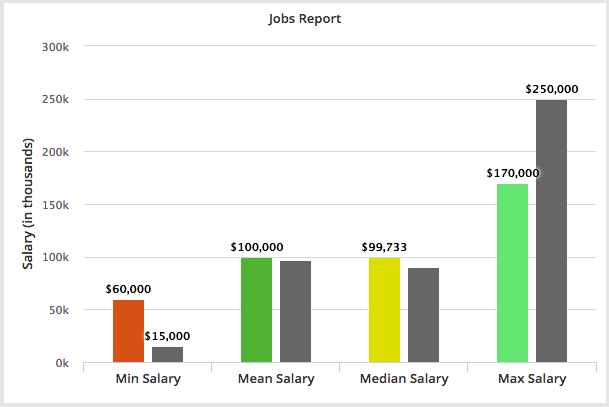[display-visualization_graph-02]
Work in tech? Curious about how your salary compares to others in your field, not to mention the tech industry as a whole? The interactive visualization above can provide some crucial insight: just click on the ‘job title’ field and use either the drop-down menu or search bar to choose your desired occupation. (Note: The visualization has just a bit of lag when first launched; if you click and nothing happens, wait a second or two.) The colored bars will show that particular job’s minimum, mean, median, and maximum salary. The gray bars, meanwhile, show the minimum, mean, median, and maximum salaries for tech professionals in general (max salaries are artificially capped at $250,000, with the implicit acknowledgement some tech pros make much more). For the purposes of this visualization, our data team examined the Dice database and selected the most common tech-job titles, excluding those that either weren’t very technical (such as some managerial roles) or were too “noisy” (i.e., overly generic: ‘accountant,’ ‘contractor,’ ‘lead,’ and so on). Of course, no salary exists in a vacuum; experience, geographical location, and other factors all come into play for each individual. For example, last month’s Dice Report, based off data from the U.S. Bureau of Labor Statistics (BLS), ranked the states with the fastest rates of tech-job growth: Utah came in first on that list, followed by Michigan, Alabama, and Illinois. In those states and cities with higher demand for tech workers, those with the right skills can expect employers to fight hard (and pay big) for their services. Indeed, those tech professionals who’ve mastered particular skills will likely earn noticeably more than others in their profession—a recent survey by Modis pegged it at a 10-15 percent premium. And compensation isn’t limited to money: another Dice survey found that companies offered a lot more than fat paychecks in order to entice tech pros to join their respective ranks. Those incentives included flexible work locations, particularly interesting or challenging assignments, flexible hours, promotions or new titles, and training or certification courses. So while no two tech salaries are necessarily the same—even if both workers have roughly equal skills and experience—the above visualization is a good starting point to see where you stand in the industry.


